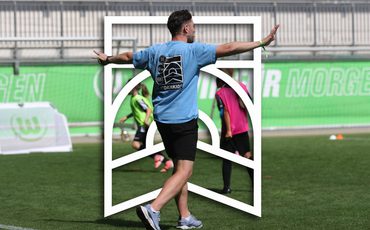
Managing variation in grassroots soccer teams from U7 to U8
with Dr. Tom Mitchell
By Dr. Thomas Mitchell, Leeds Beckett Univeristy, UK
Like many other parents watching their children playing mini soccer at under 5 and under 6 there comes a time when the coach approaches the parents to ask if they would be interested in coaching the team at under 7 level. This is the age at which teams can enter organised sets of games which are administrated by the local Football Association and subsequently the local League. These teams are initially created to play teams nearby so travel times are short. Groups of teams are also adjusted halfway through the season for teams that are winning or losing often which creates a more ability appropriate environment for the players to enjoy their football. I was one of the parents that said yes to the coach that asked if anybody would like to take the under sevens. Myself and my co-coach (a primary school teacher) felt we had a good understanding of childhood development and some understanding of football. In a range of discussions prior to the season starting we primarily felt that we wanted to develop a fun, safe environment where children can develop a set of movement capabilities that would not only see them develop football but also in a range of other activities. (Whitehead, 2001; Baily et al., 2010; Lloyd and Oliver, 2012).
One of our key indicators of success was if people coming back, second was were they having fun (Visek et al., 2015) and third were they developing movement competencies (Whitehead, 2001; Baily et al., 2010; Lloyd and Oliver, 2012, Till et al., 2020). Our initial squad size started at 10 and given this was five aside football we found we were giving players around half a game per week. Our initial interpretation was that an attendance of 100% for the vast majority of the games was a reflection of our willingness to create a fun and safe environment. However, we felt we were only giving players half a game which may not be enough to support effective development of movement and football related skills. To help combat this we adopted a ‘playing holiday’ where parents could pre book a week off, where they were not expected to attend, for example this might be for a children's party or a holiday. Having less players per game gave every player a few more minutes on the pitch to further experience playing, which further developed their movement and football related skills.
The onset of mixed abilities
Over the course of the first 10 games, we noticed that some players had developed at a rapid rate, which was beyond what we we're expecting for this age group. We also noticed that some players had barely developed any movement competencies despite our best efforts to include a range of jumping, hoping, leaping, bouncing, running, twisting and turning into our programme (Till et al, 2020). This variation in skills and abilities highlights had some challenges for both the more developed players and the least developed players within the group. For example, the ‘more developed’ players were reluctant to pass or involve the ‘less developed’ players and the ‘less developed’ players would therefore receive fewer touches of the ball despite the same number of minutes on the pitch. This may be a result of the egocentric nature of participants at this age and stage of development (Piaget, 1936).
In training, where we had more control, we would purposely mix teams up by ability and design games that forced all players to pass to each other for example a simple activity might have been that everybody needs to touch the ball in the team before you are allowed a shot on goal. Another example was when we use the Belgian suggestion (Van Der Haegen, 2020) of working 2 V 2 we would place more developed boys with and against those with similar abilities and 2 less developed sets of boys to match ability and create more competitive games. On occasion we would mix teams to have one more develop boy team up with one less developed boy and ensure that a pass must be made between them before a shot could be undertaken.
A match day was much more challenging in this respect given the fluid an unpredictable nature of the game. To accommodate the ‘more developed’ players we played one period with them altogether to give them a positive experience of playing alongside ‘more developed’ players. We would also play one period with the ‘less developed’ players together two encourage them to pass to each other more and have hopefully have more successful experience as a result of this matched approach (Eisenmann et al., 2020). We also then mixed teams up for the other two periods within the game to encourage teamwork, peer observation to support understanding that not everybody is the same ability, but we are one team.
Take away points
- Offer players opportunities to play in developmentally matched groups in training and competition.
- Ensure all sessions are fun and engaging for all with lots of repetition (e.g., Touches, passes or shots) to maximise learning and development
- Smaller groups work better to reflect the
References
Bailey, R, Collins, D, Ford, P, MacNamara, A, Toms, M, and Pearce, G. (2010). Participant development in sport: An academic review. Sports Coach UK 4: 1–134
Eisenmann, J.C., Till, K, & Baker, J. (2020) Growth, maturation and youth sports: issues and practical solutions, Annals of Human Biology, 47:4, 324-327, DOI: 10.1080/03014460.2020.1764099
Till, K., Eisenmann, J., Emmonds, S., Jones, B and Mitchell, T.O., Cowburn, I.H.J., Tee, J.C. Holmes, N. and Lloyd, R. (2020). A coaching session framework to facilitate long-term athletic development. Strength and Conditioning Journal. ISSN 1524-1602 DOI: https://doi.org/10.1519/SSC.00...
Lloyd R.S. and Oliver JL. (2012). The youth physical development model: A new approach to long-term athletic development. Strength Cond J 34: 61–72.
Piaget, J. (1936). Origins of intelligence in the child. London: Routledge & Kegan Paul.
Visek, A. J., Achrati, S. M., Mannix, H. M., McDonnell, K., Harris, B. S., & DiPietro, L. (2015). The Fun Integration Theory: Toward Sustaining Children and Adolescents Sport Participation, Journal of Physical Activity and Health, 12(3), 424-433.
Van Der Hagen, K. (2020). Dribbling Football: How a child-centred approach led Belgian youth football from 11v11 to 2v2.
Whitehead M. The concept of physical literacy. (2001). Eur J Phys Educ 6: 127–138,
Contirbutor:

Dr. Tom Mitchell
Tom is a Senior Lecturer in Sport Coaching having joined Leeds Beckett University in April 2016. Tom has a research interest in the lived experiences of youth and professional footballers and how organisational culture in professional football influences the development of their Identity. Tom has over 10 years of engagement with professional football. He provided educational support to football scholars for five years as part of their football apprenticeship through League Football Education. He has also provided sport science support to a range of professional and youth team squads throughout this time. He is also an experienced lecturer having worked in the HE in FE sector for 12 years from part time to programme leader in Sport at Doncaster College and University Centre. More recently, Tom has engaged in performance coaching activity within professional squads working with players and staff.
Comments
Related Pages


